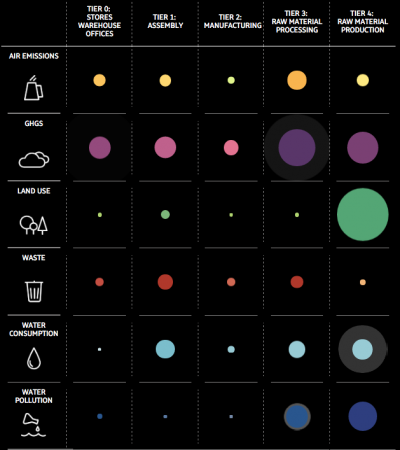What passes for common knowledge about the world’s wealthiest people is largely false, per Wealth-X.
In a recent Insights article, prospecting firm and researcher Wealth-X debunks the many often-touted myths of ultra-high-net worth individuals. Although today’s political climate and economic difficulties make it easy to generalize negatively about the wealthy, the negative reputation, earned or not, offers brands a lesson on the importance of giving back and supporting worthy causes.
"The typical UHNW philanthropist donates $28.7 million in his or her lifetime, and 65 percent of UHNW individuals donate over $1 million throughout their lifetimes."
Debunk the money
Because wealth inequality is such a common talking point in the United States today, numbers tend to get blown out of proportion. It is often said that a mere 62 individuals have as much money as the rest of the world’s population combined.
Wealth-X’s data shows instead that the wealthiest 62 people on the planet have $1.72 trillion, less than 1 percent of the world’s wealth. The 211,275 individuals with at least $30 million in assets combine for almost $30 trillion, around 13 percent of the world’s wealth.

Image courtesy of Michael Kors
It is also commonly assumed that the world’s wealthiest are all wealthy due to inheritance. In fact, of the aforementioned UHNW group with a net worth of at least $30 million, almost two-thirds are entirely self-made. The remaining group (a little more than 75,000 individuals) are evenly split between inheritance and a combination of family fortunes and their own entrepreneurship.
Relatedly, 88 percent hold at least a bachelor’s degree, a reality reflected in the volume of donations to higher education among the world’s wealthy. Although this means 12 percent did not enroll in or did not finish college, that group includes self-made billionaires such as Bill Gates, Mark Zuckerberg and the late Steve Jobs.
Again, it is often said that these wealthy individuals all graduated from Ivy League schools. While it is true that half of the 10 most popular schools for UHNWs are Ivy League and the other half – Stanford, NYU, MIT, University of Chicago and Northwestern University – are seen as elite and comparable to Ivy League schools, they still only account for 5 percent of the world’s college educated UHNWs.
Perhaps most ruinous, a handful of ungenerous wealthy people have made it easy and commonplace to believe that the wealthy do not give back. In fact, the typical UHNW donates nearly $29 million in his or her lifetime, and last year the group accounted for $112 billion in charitable contributions.
Nonetheless, there is a degree of top-heavy donations, as 35 percent of UHNWs do not donate $1 million or more during their lifetimes.

Luxury shoppers
The lesson for the luxury sector is most apparent in the myth of ungenerous billionaires: Society expects those whom have much to be generous and giving.
The proliferation of these myths against the wealthy in recent years is inextricably linked to a culture that can more readily view injustices, a reality attributable in part to the democratization offered by the Internet. With the visibility of injustice comes the urge to fight it, a mindset that extends to the habits of consumption.
Today’s politically charged and socially aware consumers are making buying decisions based on the values exemplified by the brands available. This means that the future of brands is linked to their willingness and dedication to support important issues that extend far beyond luxury.
Making a difference
Luxury conglomerate Kering is one example of a business doing its part to make the world a better place.
The Kering Foundation continued its efforts to combat violence against women for the fourth consecutive year.
Kering Foundation’s annual White Ribbon for Women campaign, in collaboration with British designer Stella McCartney, began Nov. 7 and continued to Nov. 28, the International Day for the Elimination of Violence Against Women. Philanthropic CSR shows a brand’s humanity, but maintaining a cause year-after-year is likely to leave more of an impression on consumers as it reads as more authentic (see story).
Kering is also looking to drive awareness and progress within its own organization—and more widely—with the creation of a new methodology that uses financial terminology to measure environmental impact.
The formulas and methodology the group used for its Environmental Profits & Loss Account (E P&L) is open-sourced, enabling any competitor or company in another industry to value their own “natural capital” gains and losses. Kering recognizes that as only one company among many using the same suppliers, various companies will have to work together to enact change (see story).

Kering E P&L grid
The hospitality sector is particularly dedicated to doing its part.
In just one example among many, Starwood Hotels and Resorts furthered its efforts to reduce water usage across all its properties.
Efforts to conserve water will include more efficient irrigation, low-flow faucets, collecting and recycling water and an option for customers to request reduced housekeeping services in exchange for Starpoints, a voucher or a charitable donation. The initiative cements Starwood as a leader in water conservation efforts, emphasizes its global awareness and is likely to appeal to a younger, more environmentally-conscious demographic (see story).
{"ct":"AuXl8933++4SNPOgIP4L2uMJpv1M3kELIdtStyGzPRg3kaWVlZ02XpB4dexnJr5X4Vg53p+gLnEyyxCf9Mea+SfZ0\/Wkf5bM2dIUI8kXy5wQhd6HnYXnPcXRL4ZhV9N3jLiT865MogWldylLFfq\/vR0abp3+kC4YNDY1lOAF4xV02oCNZBB\/fPudlXl6nniLqNn6ngz7TdabmpiydcdrF6vJ2AHme1lqS207er4Avdts2hQCIRHc5IG5c07GNtNzjOYHJKtVhISDs\/hTk0Zv9zNX55EWQXzKW8oEZd6vCd21e9ZoSGZB12wvDr8aleNwrbzp3tVfb4dCi0YIEmIdSj91nyFkw9eF4jZ\/5sl355AU1pqtKMBD7zDx6YIG0tQfo+1IUecVTtx7tkM2dA2VQvH9KkxEQETZi1VFWAKqjapqXm27iE3CzgK9154N+6lLsRGRiEL4Qc4lKQkbPoNN3WCj1FNv1zcLdVroDA7PtBDPb7VI8wbzZmn3ZiNuKi47CVnEdcHUs\/rABOGD9tkP6XoZ+TeZ69FQFpnW59sSTyuqyIGy47TLKKfveNwZrH55\/xflI56Xerztq+mRgPF4RYqgogxnu1CVsjDodkECuvUU9DZubsUw\/NajSYTh2ot0s7zij9kyx9tyddjFn1LmBCIF3knAZ\/10VrRX79Pd3uOZdHDZlrXQAEBLOczyZz3NOFc4gScyijgxIwL5OEGHk8EHOIAOI6syJbcGZUNdgJymDuTyvfDPmIlKlEA4444HjZjhhDCbffsRGaSn0eIvYwm\/8NDo7W6RNHydxoySDu6lJfUgTBY1IE+8kP2Chv8oGw1\/Buw6bkSPtvv5STJwAjFNN3Jow5IAlKPu+reLsBYu3\/IPBKxVD9OeZ8x1UB3JRdNMV+xgmX9dV3XvoRTeMYfpZNem8F7+6TW39bqByxiOJOcasn2QCk9D8O2NwsD\/5nsnygcuwcGyO2sunJh4ubbvMKGHIEIbH+GZLd5XcNeh78Qvcj\/FqvhOpAOWIlLemRSIEaWXaZ0rFc3ZOBE36ADhBxXFmmgWdtCTtKiJV6NXlFjli7jvl42BlLuwD+nM9T+4rtaOrZrYzM8UCFmUfpywlIg+dq3zhL6yCr69qtUDRjOF5S27hw\/LK9k2Ou1s7C\/TVfL0Va5GvJQ3Pbltox4kEtogvUxZZCwE7+aLu8VtHxyfhcOnf8JunRrzBos08qXbNcA\/CXbDMTMvoLmeKIAIXhcSbVg8uPtj10oSExS\/Tsd+Fgp3kME4W48U8Fk2S8xN7p+iDJbdf+HcAfn4bU+D33gLmLUInKtbZ6nDSFRmNywJ6NC5t1F1KYq8sc2x0fgr8o1cNMUmqSIFoqkTYwBsmW4\/3hOlE\/WSJAn8qSWr7bUWuWNNKKIJZIgXGD2pgHBhybhbZm6lrobsp56MtE+K1GGU7rXNHGXdwkrXAT5Soja8\/PgO2s1LitNBGcUWp+hfWWCTCDjVk+EiCZ0F7KD7I9VyeJ8Yh9BtJd+rPPzvudgletRUaeWs\/3cIWf1IZ9o7n\/4ZB8Kc8GBxbs08POGx4WYgh\/grWVfObcjKwQROKggia4oqe066GoKRnNbDwYNMdyc9\/2CNtIUAvmCS2aCthhG1fjFsu0\/N\/MkOICekV+PVyNVDWe0rJQ8zDH8NIj3p+XMsLtZi9XQO\/b\/lUw5nG+eCottnmRSAG5FRENcECkpg9TxzAz9lbeL6rdIovX2Ex92Y0NzhRn\/UVwhHaFeY1oy8zA4Exu\/SzZMEsu2wzTbR0uLPRSgKp5EkQniwNhx\/gIKvUA\/4KE+J5NuPsflzUHjIWuu5uqp\/5KgPj6wGoBXiLo99OytXsNfStKYc\/k050Eq8TX0NFSkqo7z0xnoIQqE38G1EYx5009Qb+oSP2DRFtcIN0\/cfzbe8vXtRfvQZP6vivbvFx2IDQnko8fo6OxUL4cLx0JUuMDVfFRFcKo33b3h\/M2ugHi8qKGlqpMFNDUvje9rvw5ebxptCgtDnIybZH9q7esxqljLV4qHNEgxGyNQrKdfZbzpvoLozDQf33CVRiBGlmR9Q3+Ne\/jV6KHWiSyABzQorQopK75utrIsS135HfitISmk1+yWZt72i1alGTzxS0e8MlTdyFMbihRT4QnuEuJR2+SzJ9WmxTZaEdV3xmthzvdNLQqJjZgMXl+DtTGfjB0WmlR8KtwPcyGCNOK+fE4YYn4wmO3LfluATUfmdfNFhjtnk99bCnF2NIkV1PITzCPvpa2kQIBSk9efbsZAKy9JHe9CXzNm58ZdNUK5PGQXDnIj7n6DYvffE2nGLVmSX0sRRFB\/eJUOJNRn1qm2WgOQHoeAuL6NFRscZWjeP04tgMAKOzfBanZPncbc9r6GF7Im3LxvPg1eJVULA0aM1aTDfi9PJc\/\/CpUrqHa4kWtJiuvrJIAH3nGKXvHoyKjffH8D4zOxpTZ7xymJGsT6Hb7c6osfLqgDmsX9en+PbnDWVAGW71ythzAcP4nUG5qp\/gzeF+z367XNZZj0U0WGnp\/GOVgIAFC9h31Cca\/n7+FDtLoSsZN9H8tJZ8Yyvf2IaR2ricUtXecZHQLnYiNyOtnwMCRw1KUsX3pNpGYd1jJjbQrn0ZfSzpO78eUkktiMEdeJSzieZoCxwDlXXDHUHDj3fQOyHz4l5Rio1f8Eu3KYHYMSttEZfl\/wQUxJG\/BjHNNFtLSRae2Kv7wv3Xuc4c4fm3sZF+VAvsWupQvKQptbBVd3FF7LIh4GtIZasPDv+S+E4050uEclUkgEgN1coEnrURaKNFQM8oeQSQwgYyeD1QtpoVwFQAfIfZnVGVFEWv4ct\/AJAzVZIay3lmTHzSyj9DzjqfEmtA4JgsmGXF24N6b1LJOBGOIxQzCrL9lPl+r4ziuORm1FbtBmCCuX7Gplkz2UTdQJ5jLQ\/9OI9V8dPvp98bXHzjq4OQ4VZ0MYn9CDUkRvREbritsI7HERlXS32YjsCjduR+dl\/zaoATsC3xDvusDGFRrs1GSMmUymfCP23TP2tqmz1sc1cLe0qdYq874FHEbTO09H0Y24JMcuJ00h0TA8RLwC\/CSRghjP3qp77+f0xnH38ULjVo3nn12f4+SExpbCxLgVdHKRQyheHcC8DKuVdE3gMPz4oQo6qCiV+dTUldadcieWLoOypWCPXl4liZC35Ckbog7YgfR5H86CmE4PkIxjwSHWs2lEwsZx8FfJZanYbbJKcQpCw6kMQnwN0AfIgIP3t2YHmUPLmfhr65St2a30JvbIkgxZf7udsgh2vMV\/M+7rykI8+eOXYrYJaUHNXopC+SM76XbB6tbrGhmxZZAr66MYErEOVkLkoO6dYRgIvwPEV+LWjkgwE4Uj9nQqEbgLx3IF4fKl55vKQ4ZLx2+rhwNqYf\/8kSF6BOo+bGiNml5c3YLx2FPqfNPxPe+ekiDW+9Jvfza65pbK1wCNf4rCFhrdPmkqXTd9es6DLVUT4rVqVFbIhYogatQmAywyHRWedYn7gWxPJ9VXtgkSKiOXX7rg4DFukrSIVjLayO3X4R4Lh0U+ny9Ah+eD2uHm4Ftezd+Lv\/slT9sAzEr7IuYlSmv5kCNI0DaSsM5LAp7V34dZF4zr8kaCekjtawmVzyRC6SYfeNyfDkbBcthvW7mYaGeJiE5nPgFoBv\/dNXCO93ztoBklFSIo\/PyGr1zen3BvtTgr77SfMKqSXZ14sKnKuLnZSt4C+KUn6uvGBjv8lt6VosiCZtRsJCOuhErdvQmQlVTyF46\/tiEFyteuU6IV8TmwuVCuA2\/cd71FMvH9nIXC2j2F40\/Vl7BvmIMOnv9W3iYF5MXsS+lAv\/XaES0aHEhF9G+RDUpSz3qjzQ\/zY3fegwySSlYA6Trfjs52fWNlvAXjUtD8JBVMVIXvXGinT9jN+v+b4Gc954l6ZVg\/MOsLsGFyD0+gGApOC0eo2rrsxSs8oGLTL2f0NAybn0ksPtnHHsx\/wxbT29CCUfA7dSYEn4S1YdkO8t2EyZB+R2gOQV5UZpFUqNUD+tS6\/DUHNDaWtMEdn59WPIowJdwxINoyh8+XYgERYbnPINORb0mHOfCt8dv98IdtzxtdXX8DfKWODIEQcPscpZn0L1gm7uXAD9Foh1rGROXIFBDPIlGJDVFXq3tCYD6si1sVC2dFxX\/XOJxuELaxmgw+jSO86L2uLQNPucz2bsSPE2rOBAwUOB3B5QAvPVzhjrTbaMRLSrTdcRkDBTyLUQYW\/cBi+VySEQxOxtNXMvu+ecfid2JTZQzND5oLWa+S\/jCvh+DrcZ3LQKKBKTf+ODIhBRUBQps7ACh1yi0FUNqlglBlWA0MeLPxIY20v3FIvYpiKY6CmXRGvzPpDoRehnTjqrDil6QmzguEREEJvWzBNsE18eGMQ4uTijOTDGZPHKSfjMZ08wUqlaMZY4qPv45dV7Bk7JaiK8JXPytvPU8CTEdxgiSrE2nyd2ArDIrxzjYNWiGqfyrBee\/LiBI8t9FMvJR5BwqM\/v5RzIcDbZ0h4PG8jsLopKhMel7wsEZl9bpXca7WTGiolDU9pRzeSBWy0AgZatrsAvqR\/4mA0DsiaK+EJ9FBN4OyIK4uilsS1T+fQjdVW5qyFZvJQdFMETEVtHmyHht6wKKWSIU2JPm9Djjb8L7O639eW3hQvNopQlGnGwJezgOmyzeFE\/mgf7CdEUckjbKKamDd2un6V6DkRzdJaUwvlTJaT8CRSqLsHPLxCKsvR4Wu8pXmQFz3E+ljp74HYwowsDY8V8cMJ80tluz56urs6QxnLJjug7jRcAErMZxZfmkZezH7xxR77PLTudKFDQTP41QznWyhsGQpvFWDC0KfrPhp8uQ3Eg7EXSR+u3KitN7NAGzZpVWgtMvj5G5WiPXCMM8x1RGVc8YtudBco+\/g9yait8jLWXkxPlsxUut\/Ulq4TaNtRt89l6xWMULgdM5oUX6YDRWOt8ul2T0r059mSW9euA\/rslfJO\/iiynwMdcUPhiskUImjPbjErllhEQxlNvfp6y7ViTc8Fx5BE3xkKOxmE\/ijCnNqdVZomwhZWB4hM89AXZ0R4aCava9qSPlIg8BL+d4\/33UPUgurwR9R2fQVTTroO3O5SdjRwonMiS2ommv30hUukAMF8efX+Tb08njOVeaHv8iX2etXi+l9W32mo9BAF\/CK1judeYTjcobj+j40Uem7kTR9gic4UtXMtD6JaM5Gy8d88HMt+FRTM1tJ7LBQpFVvK\/PPEQmSacG5ZEWmIVSPR5XGFxU+Sk7PfC3lcpyXafd0r7E1nS93+OAcXXiH3K3dSf66N5pKNMGdPXvGiaLic+Im\/hD4gsa2O3mrrzmxjjgz20sO+usfRz+4o929ijnLZoNp45WbUrTlQWNPjvdACx+eflrR9hUg2jWyiuWoY3NcmdVjJ6bAuOVj6wwjhmaEvrlVXwpa1yveCboSl5QVomw2IbVHxp0bB\/E9UsGxANRiEHQcZolKAgT59M4hhxICPwaorTnLh2Z9VPDNLItmMyBEKyIo6apRJRF3tK2QdWk4erG3JdGY+2XDx6ul6bc8QdqWt68vCH5rTRfu8P+LbYAnPHKrKuPWeywS\/8URk1DugVPXsRLts6Zj9Ag5bqGL93nSl6J8Yr3gbNzO5U4NJ46YLK03lnX\/H5psqqfhmp3epZAZBwUZAh+abi9sZDRwwaasM+8u6bTb1y\/jR3ZZJFb+6PIc21dSzeVIabL9bNSHg9nLdC9c+tc55DgDNAfqNAOOWhmvv0TAOiWVeDurw3L\/UTpe8sUzYLieLdXYOq6FwdHRV2gV8xmmspr1tOfBTST3fAZpfpC8IccEql3jEaXmavqFmU9Iv9rMi1Pp6lmx3dmtzujquHaEBS9at2cQoyhZ5FM9UW0PeSGLEAdTH5sp44AsgD7Zm2gYg5p\/gnfI205cupl9C9hWAVkndJnTOV8NGdTN9YekuXa1ORk1JrJTO1TKer7fxEijmcdUNPwKlWDiiEOBGBdtFXz6uHzh2\/Ni\/7M0\/GmdrM6GOOtXra4v4ms4Z6fF6rjrUMk5lE2DnATb+mjgr0mpbte7q5i7rEflnC\/LrPBD6IAqO7zn2hn\/Jav0uUK7s1J3Y8JZoVWPBDkbcFIddfwMYND9soGBABQO0ZyN79EHEUILic7KpVa1eZfkbm3MxyIp2wnYm1A3OmYd7XCasjk5SAyINThBtZGRAkgctWS0Bnm+lpJ8Sch0gdaYH0YSCIIdeSqMjr034M0v3ef5sd2yKNV1B\/gvpNLhlKpxpManoxQxDGfpVULkWi\/c+eAlwRqmnSe2sLBybDiqkik\/CO72vmLTL3\/oT58Ql\/xQno+keJgFs+t7wl4lAn\/vylvpF8qvjkO0mns4VbKF0PvrhibJKPhGyI75aTcOsjTC1jluZPwqo6q6AV4gk0bkuCxGMJPfrHNmAU6fcnznDE6axy2QOx3bDBuiuPzqqf698GCAdnNSI3sK3Nrs6MR0l0yz3IRHALow8XryT2XaNUzCQ5L8i4Xwy00GU4GMdJQ9gDgP30kcoF1wBs0F4TgMTfy+xJ+MuZlCOYt2lhZMFBnKCZ05Nu1oQUPpcnROTbjFiwI6xmPjg11dAbuqu5j8tvQHLqSETIFWQIhif2PKdd5CS1dN06IJ6Nd85S5lfk\/3oPHsZRLolFrAroIf\/GSuAKt3fOkZOKqtfmwjULhbLbGNwW1RLD6LSGEpIjXnsp676m4UhVHjD42dKPlVEh76gJZL268qa5Fu6TSxnIlX0tGf7dEU90WddtqIW1HxQjtECkkS2swV9ZelEf8aGGlVU3a9alF679ZpgC\/4K\/Ew8G3hGIyHjztKNFzsCAguSub3YQ8PvLMjAFRRUUEjRGH16zvRX8KSC5Er3fFYHiaFJnsmKeoe5UxfQUjwQJw7QRQQZLSr0twqoh85FwC75li0tcu5G9c3wIZEJeLoV1K1n2dBri5PJKhCP051B4+VFMVgVeJGXFvAnqM+Kkfd6X\/J5d+3zdQA+iQ\/4o\/K\/ClYS1j1A2To\/lAgATHnf3eDk8RHQnAg4NgN22IP1v3IB9o82MLwDttQTGAdsIZXscSm+l7oJKp43WZ9HJI3RlcyFbtXq8EbQI1m+zFgVwu061fFiuCosNhlMMwEaUU66UDazx+n7eYO49HqWKeZtjnZKOaxICNzZByuIavN8kwTJjG+8eqJHwcd\/5zx\/dPuiNoguoMpcRVTQfkP33WCwVFWoEKivEI21L9OMc2sqANFtjltsggHOuuTMphauxik9QXV3kpSbiJKUwndBPVAbqJlHyD5n4Yl5yA4DiZdLXGHk6V8e\/Q3omfYlsNOciYwBZ2fiteHWj7JPwHnRC6qPtkR6UqurPZ8YSbp4TL5MBkU0NFLrkTbpW0mXGQ4hDNGFqxze9F6\/zcqDeKMlHr3HFFWEUnA7vEe1NCei44QW79\/DxSZ4uePovMb9sSiCdYpL0Aka2WBq3uFCYpOgOooRvZl2EXvV1g7NdsWd3PtZVK+oIaKsVYZgvkEfaG9CxAaTaCyFwRLeDepAl1JHQApc7KpMACsDru6hIQe4NXgnCeaKyLbBZYXUoacmMySq2eMeBmQXs1DpgcDx9h6NXKSerPpguLO6pARMc+BEsVlBL71ZWWgbvfM9vA9+0Rs9D4WYl4XiXLN38nrG3R2TOT+jll03SOjLiXjFHiEpN6EDgzcA4KGGacBcXU7WOlQXJqiIXl82jueow8ZURrkVeWAh2ZZwe5FX6zrdZoQxPLTjGusl7MsbZnZh02l5x0+xIbB\/DNWM9290kLloBhj57vsf+OXROHot4MZnUJX5e194KGYlDhNY1LbW\/EwDWPcTrNZVgQSL+ouhX53\/rapWHMWdzYbzblO77iCp8beYoZk0TAWNSk+2k\/jKcy0hH5eVv7Hf0oinNW5B4P24as25KJazELMGtkWbZcgSyvrGD0\/WCdjzegtc\/Jn4vEHwVn6X3wgC4U8VVc2vxhb96ZtHct5KkeqN5siT6uACm8Hc+OO0oUCNPCzkf3s1aWq\/S3JaAkAXNoixIElXiIapAEnkexEbnD\/tB\/3+jMPeAUVepYjT77+lNE\/HxKY88+1C+BfjGu7sm9sOrdB4\/tHB3DVnfOR+0nilFa7ZTH9R5IpjDKVqP8PdghJGwVaZOz33pe9NXGXvIgdenFWJO09gUyPuOUKKXzph3MlaYrMUk0hlN0kLjVuHIbk1cdJmBDPdTh\/\/XYmsjOWF\/022j43GAwyDptdVv88yBlNo05ZhUC4dgR14h\/GAn0V2Z18ZNZ4CPKxA\/N7Dw4GnRdXKuQlNfBlKRe1JxvGg4CJzAdu0UKFLJGHlfwMy7f16PqHbZLOdO3pesO4hxyJPXgRVkcUuE8RpAbVz6AItOLavdfZwd0myHY7C7PQOauojm1be9U8xO6YlubdKvrpp\/R5ITRGRy5AqQypdamMjSG4ONRBK+XePmysztq7Bz4hFEqsxatW87pdAS5fAgdHQ0e7jFF7AVykrM945MvHuPOJK6WV\/F6XDTRw2YVJafV15F7bBqqrOLqxoEjJYO8beR\/\/Qi1ESJURPFuhWtjQZFNAw9pGILNfPhe00jApVett59GXG7wJYRIhYiI3CkgFpPYvtTzUfypKzovx8kD5Ahba4qf9klQM87Pc9vbZNzdGJ4VZnOqgWh9K8rpRxRr8N0xVqtiS2ueuzaRwm2O9wowj7oVoRcIXiP327F+PyCE3rXW\/nKoKNmBaZqz9IYqDLZ1SGeNkwYMoOjmbSR8aOMlxwzxCpKI84LmY2Z6nudniGSfSBM2zth2zcIREjUT1DfcZTy3S3g\/gjpOOp\/qC+AcCCm7iX35XJ1cpvDzVU\/F0VVRc61RZjq8crGzuP2CWzQUx6Vv+LS56IaitYulZ\/qPYW92KDNr9lDAfSrL87HnkXtLeJpdED7RTMiQoV03+bxryE+Bwj4ak2\/dpOWO6de\/HOj1PudK+v3pxK5XBAXdexadRLhi3H5CrYe9gKtd9WQTj9RvVegjV0U+fLGHsv1hQBOHsFoFM7JY6y2k2RTdV2piV3EXwrLl0wAXHYPDQKOTPqiEBzUcxQoIenQWy1H8ZuNmAhShJv07yB6WQee6kEb6YLUKR4zPoKkUMq9OvWa8ss1ZhnLdhPVZlGlvGxZy0fB+V1JBkgR3A6heysAnyepHxuK2oxdJ33p58CdF6r+OmfcDjmwOYlvjReXSu4Bj2tosV58vjniIbQp3i8VWwItsxBg7o+mioyLdFJ3jcpcbx4SQpfgt43BUyLgn4Y0pNAzgpVsOFWup80dnA0yCUBoY2kwMIn0XaLJb\/wpOgPHVBrReJQjEnZ7UWmrtYSkrC4\/4d40RfLcbN8WFqp9CONNoMhe1ab8ldlMOfUv0B5AfwYt7PgTNIq+pw+CODXrBTkn5dR302sWhbxCrF1Vr5B3jRcaZplXXuumUsWYdNMKmc\/75fx3YbP8b804ypdOfXhJDs5v9H+V3paJ+Bv2foA38C\/JMQQEwJm8YTqz6UzaB3TNUaf\/PU+xyhcpcDpxoDsPb8iRshUm\/qsXCLm+R3TZpQUsjUUYhgHGiauCsFQPEhDJA0gtzzVLK1dm+CKyrswEvBkel4pcHp6cVlWi\/QPw5glAvxPSaLA+\/K31hZKY5AivU0OBnKbLyR4MkrFwu8gAV8\/qrfpsCg6mqgJX7OfO5AKHW9Hl5z3Mk\/wjTAy4F1bGS98i61\/yHI5p442Y76rOa6r\/rddzNnR\/UquO5vwUZvyvFmn5FFhoAYQtN9o4EQjGO1TfW7di3jJoY\/Rt4yLDylEG8z2qoT5NYPeQnnziKVV7zLIr1zUO2ISHm4=","iv":"7f92e1c26db74c6bd5119854d837ce6f","s":"f7ec431cfa7b8d94"}
